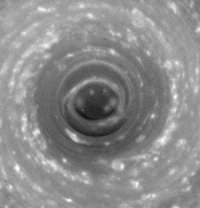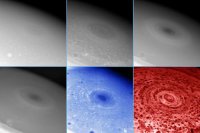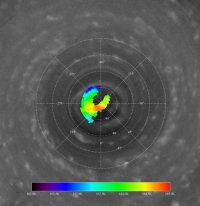South Polar Storms on Saturn
14 November 2006
The instruments on board the Cassini spacecraft have observed an enormous storm raging in the atmosphere above Saturn's south pole. This type and scale of storm has never before been seen on another planet.Images of the storm show it to be very similar in morphology to hurricanes on Earth, with a well-developed eye some 1500 km across, surrounded by a ~300 km wide ring of towering clouds. From the central ring, two spiral arms of clouds extend outwards and the entire storm measures ~8000 km across.
By analysing images of the storm taken with different Sun illumination angles, the height of the clouds relative to the central eye can be estimated. The clouds were found to tower 30-75 km above those in the centre, which is much higher than the ~15 km in similar storms on Earth.
The south polar area has been observed at different wavelengths in the visual and infrared by Cassini's Imaging Science Subsystem (ISS) and the Visual and Infrared Mapping Spectrometer (VIMS). In the below set of 6 images, the ISS images are in greyscale and the VIMS images in false-colour.
Over the eye, at the altitudes normally inhabited by bright ammonia clouds, there is a hole in the cloud layer and we can look deeper into Saturn's atmosphere. In the last two of the ISS images, this results in the eye to appear darker. At the concerned wavelengths (728 and 890 nm) methane gas absorbs light and only the highest clouds are visible, but these are absent over the eye of the storm
The absence of high clouds is also underlined by the brightness of the eye in the last image at 5.0 μm (with red colour scheme). At 5 μm, the lack of clouds at higher altitudes allows for the planet's thermal emission from below to escape, making the region appear brighter.
The dark spots in the two VIMS images are all smaller storms that are well developed and extend deep into the atmosphere, making them good absorbers of the thermal emission from the planet below. They therefore stand out in silhouette.
Polar Hot Spot
Observations by the Composite Infrared Spectrometer (CIRS) taken at the same time, but imaging higer altitudes, reveal a very small hot spot over the south pole coinciding with the eye of the storm.
The measured temperature increase of ~2 Kelvin suggests that the atmosphere sinks over the south pole, with the increase in pressure causing the atmosphere to become compressed and heated up.
Seasonal Influences
The two VIMS images show the large number (hundreds) of smaller storms over the entire south polar region. This indicates the sheer extent of convective activity in the atmosphere there.
It is expected that the fact it is currently summer on Saturn's southern hemisphere plays a role. Follow-up observations over the next few years will help shed more light on the impact of the seasons on the convective activity at the south pole.



